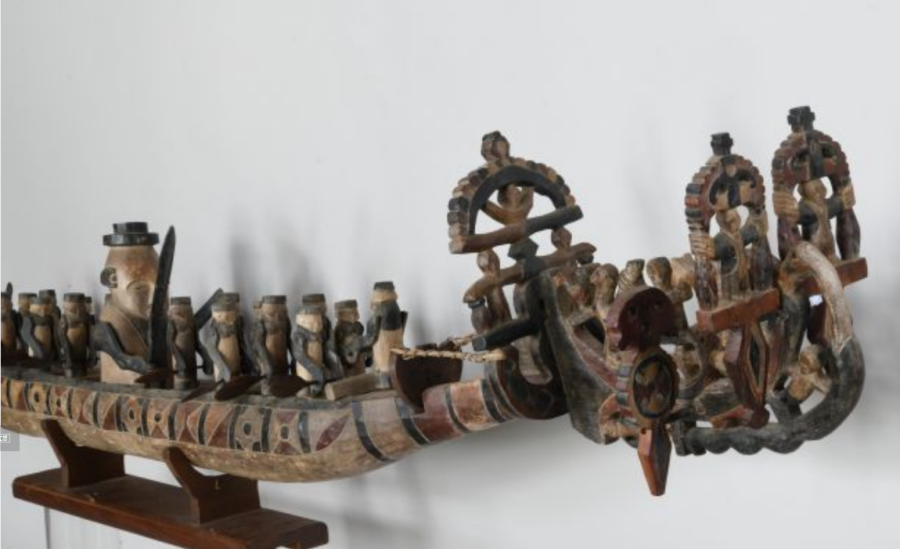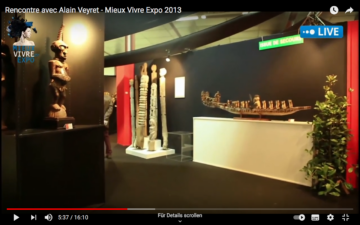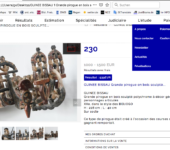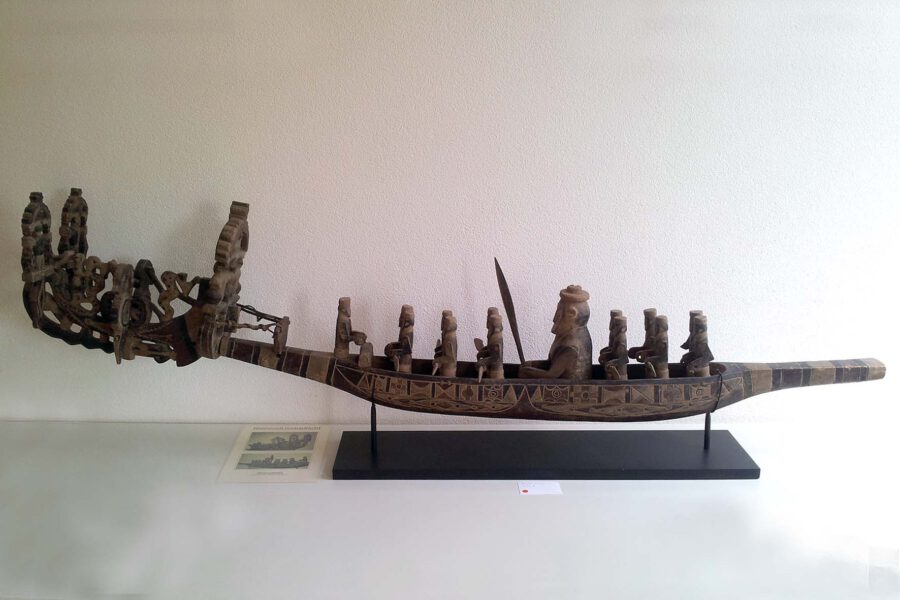*
On the trails of the twenty-seven model boats Leo Frobenius presented in 1897, my inquiries were well received throughout Europe and the USA. In the meantime I have come across the boat beak (‚tange‘) of my boat – described in post (2/3) – on three more models. Two of them are now in museums, two with modern private collectors.
Post (7a) put us back in the year 1925 and we were able to follow a boat model from J.F.G. Umlauff Company in Hamburg to the Field Museum of Natural History in Chicago. We even met the legendary art collector Baron von der Heydt.
The other three canoe models have only reached Europe or America in the last two decades. There is some evidence that they were brought directly from Cameroon. My acquisition history was told in post (2/3).
Owen D. Mort Jr. and Alain Veyret deserve particular interest with their biographies, which are typical for many collectors.
*
The SNITE Museum of Art on the University of Notre Dame, South Bend, Indiana campus owns a model boat donated by collector Owen D. Mort Jr.
Owen D. Mort Junior was one of the collectors who stayed longer in Africa and discovered the African arts for themselves there. The Snite Art Museum owes more than half of its Africa collection to the donation of over a thousand objects, supplemented by Mort’s written papers.
He only acquired the boat model in 2005 from a traveling Cameroonian dealer in Arizona. „His diary and other notes show that he had little idea of what he was buying.“ (E.Morton) No surprise given such a little-known type of object. The carbon-14 dating, which has since been established at the Universities of Notre Dame and Vienna, determines the time of origin towards the end of the nineteenth century. (Message from E. Morton, Wabash College, by email)
Collector’s portrait Owen D. Mort jr.
All Information and images are from: Elizabeth Gron Morton – Dimensions of Power, 2018 exhibition at The Snite Museum of Art, University of Notre Dame, South Bend Indiana 99pp. Mullen Books, Columbia Pennsylvania $ 45 (LINK) (Additional links are at the end; numbers in parentheses are page numbers)
Mort lived as an engineer between 1974 and 1982 in what was then Zaire. He started collecting on a limited budget just as the Mobutu economic crisis began. The acquisition budget of the ambitious Institut des Musées nationaux du Zaïre. (I.N.M.Z.) was soon exhausted. The suppliers were increasingly looking for their customers among the resident whites. Even experts from the I.M.N.Z. became traders. Mort regularly attended the meetings of expatriate collectors and connoisseurs in hotels and private homes. The circle was under the influence of the dazzling art dealer Patrick Claes, who previously supplied mainly the I.M.N.Z. . The competition among collectors for “authentic pieces” was downright obsessive. As a result, Mort endeavored to no longer allow himself to be manipulated by experts, dealers and copyists. Now he used work stays in the interior of the country to bargain for ‚art‘ in the villages.
With other collectors he also visited copyist workshops in Kinshasa, where they were interested in the methods of forgery and falsification. On the basis of his notes he left with the Snite Museum, Elizabeth Morton describes various forms of cat and mouse games between craftsmen and customers. Such commercial carvers worked for their surroundings as well as for strangers. That has been the norm for a long time.
Over time, Mort held these craftsmen in high esteem. So he started collecting in two different ways. There were the ‚authentic‘ acquisitions within the framework of the group, besides which he acquired ‚art‘, he consciously bought ‚fakes‘ if their workmanship was brilliant in his eyes. (17)
In the early 1990s he returned to America and bought from itinerant dealers, as we know them in Europe too. Initially, he limited himself to ‘antique’ objects such as weapons and equipment, which were less noticed by museums and retailers. With a view to publishing his collection, he began to familiarize himself with specialist’s books, at the same time collecting fine authentic pieces again. He received information from ex-partners of the I.M.N.Z. Joseph Cornet and Charles Henault The institution „imploded“ when the seriously ill Mobutu brought objects from the museum to international trade on a large scale in 1998. Under the victorious Kabila, the IMNZ then fell into the hands of a regime-linked mafia. (19)
Mort’s book project also included the collection of Charles Henault, the jazz musician who had become an ethnomusicologist in the service of the I.N.M.Z. Elizabeth G. Morton characterizes Mort’s passionate manuscript as not fully professional. Nevertheless, she does not want to miss the detailed descriptions and the corresponding illustrations.
Mort was initially under the strong influence of Cornet, so he divided the Congo into geographical regions and divided them according to ethnic groups. The question of „authenticity“ preoccupied him a lot. Western-influenced and Christian art instead did not cause him any problems, and he admitted the dead end into of his attempts to locate in individual cases, as numerous works of art that did not correspond to any known style. In Kinshasa they were typically dismissed as fakes. But many regions, sometimes not even connected, had interchangeable styles. Mort found, brand new artistic styles emerged in certain kingdoms and ethnic groups as they grew or encountered outsiders (6). The recognition traditional arts‘ dynamism opened his eyes to the innovations of contemporary artisans and to the value of their work, even if it was not intended for „authentic“ purposes. Mort also believed that many ethnic groups were ritually using various objects as late as the 1970s, and artisans were still producing for that market. And he was convinced that such carvings were just as ‚authentic‘ as any object that was ever made in Africa.
During various engineering projects in America, he bought items like the model boat from itinerant dealers. He had early contact with the director of the Snite Museum. Before his death in 2012, he bequeathed his collection to the Snite Museum.
LINKS:
- Snite Museum of Art: https://sniteartmuseum.nd.edu/
- I.N.M.Z. (aktuell ) fr.wikipedia
- Patrick Claes: He collected for Mobutus I.N.M.Z .. Even then, he sold unaccepted items to collectors and dealers. He is the father of Didier and Alexandre Claes, who run the trendy Africa gallery DIDIER CLAES in Brussels Link to Handelsblatt 5.3.2019
- About the clientele of African carvers e.g. Zoé Strother about Pende sculptors in the blog “Matala” in the section “Business policy… 1989”
- Joseph-Aurélien Cornet, Missionary, anthropologue, and Art historian: fr.wikipédia
- Charles Henault, Obituary 2012 in “Sanza” (french)
*
Alain Veyret (1947-2021) – publisher, politician, collector, educator
In June 2021, a very nice Duala boat model was offered in Lyon and, due to lack of interest, it was auctioned at a bargain price. According to the boat’s beak, it belongs to the group of models in South Bend, Chicago and mine in Frankfurt. An American friend who had missed the auction sent me the link, so I could get an idea of the boat and collector through the press and on Youtube.
The obituary of his ECOMEDIA publishing group from January 8, 2021 recalls the life of the entrepreneur and collector. I translate and stretch the most important passages:
„Entrepreneurial passion in the press and politics“
Alain Veyret, who was born in Lyon, decided to go to the provinces after completing his studies and “May ’68” in Paris. He worked in Annecy for the local president of the Radical Party (‚left center‘), a printer and owner of the small weekly newspaper Le Républicain Savoyard, initially on a voluntary basis, then as a partner. In 1987 he took over the title and gave it a successful profile as a business journal. His original analyzes quickly made the title popular. In 1998 he was able to merge it with the Affaires Savoyardes to form the Éco des Pays de Savoie and to use it as a mouthpiece for the rapprochement between Savoy and Haute-Savoie and the creation of a Savoy region. He was in the press to take sides, not just to cover stories. That sparked long debates in the editorial office! His professional adventure lasted almost fifty years. The success served the political struggles he wanted to wage: the merger of the two departments, the Olympic Games in Albertville-Lyon-Turin, the rapprochement with Geneva, more recently the Olympic project and the Annecy Congress Center. During this time, in 1990, he expanded his enterprises to include the monthly women’s magazine Actives, now Activ’Mag. More recently, he has further expanded his press group and successively bought Le Courrier Économie de Bourg-en-Bresse (now Éco de l’Ain), Le Courrier Liberté (now Éco Nord-Isère) and the cross-border magazine The Extension. Today the publishing group employs around fifty people.
Journalism and Politics: This back and forth between two passions characterised him. He had already been a parliamentary assistant to Charles Bosson and was elected in 1979 General Councillor of the north-west canton of Annecy around his stronghold Poisy. His political career ended in 2004 when he lost the departmental elections.
During his last tenure in 2003 he was Vice President for Culture of Haute-Savoie, an obvious responsibility for the art-loving collector, be it model trains, historical posters and above all African art, with which he set standards.
This enthusiast never considered retirement and continued to come to the paper daily to discuss press coverage, ideas, and the news. The creator of „ECO“ suddenly died the January 1st at the age of 74 in his personal office in Poisy. One of his last battles he could not win, to create a museum for the extraordinary collection that he had built up on many trips.
An „African of the Heart“ – A passionate Lover of Africa“!
A 16-minutes interview with Alain Veyret is available on youtube which “Roche expo TV” put online in 2013. The occasion was his exhibition „Rêves et Cauchemars de l’Afrique“ as part of the annual three-day consumer exhibition „Mieux Vivre Expo“ („Better Living Expo“) in the „Parc des Expositions de la Haute Savoie“ in 74800 La Roche sur Foron between Annecy and Geneva.
I will summarize Veyret’s key messages. With Veyret’s clear and deliberate narrative style that wasn’t really difficult.
Veyret always looked for holiday destinations off the tourist sphere, first in Madagascar, then on the African mainland. At first, like everyone else, he traveled for the fauna and flora and to experience picturesque sunsets and giraffes. Then he Africans made him know more hidden and intimate facets of their material culture. For nearly thirty years he traveled to Africa once a year year and acquired around three thousand sculptures. At some point the house was full of it. With a certain amount, collecting no longer made sense for him if he didn’t find an audience with whom to share his passion. For the 2013 Expo “Better Living”, Veyret arranged three hundred of these objects on 300 square meters. He arranged them in thematic groups, such as motherhood, horse and rider, music e.t.c.
They illustrate aspects of Africa’s reality, as the slogan “African Dreams and Nightmares suggests. It is not ‚art‘ in a decorative sense where aesthetics come first. Instead, the objects serve Africans in precise ritual contexts, for example to have children, to get connected with the ancestors and to overcome illnesses. And when the purpose has been achieved, they are as superfluous as empty drug boxes. (5’10“) They generally serve moral education (éducation morale et civique). Statues are not acting representatives of gods, but prayers, they serve as mediators between two worlds, just as Christian images of Saints do.
The talk turns to audience reactions: Many people come several times because they made discoveries there, for example the fascinating colors of the Mali puppets, or the evidence of witchcraft that must irritate a person raised in a Cartesian spirit. „Witches and fetishes are a reality“ (9’25 ’) There are still many prejudices today. Not long ago, such an exhibition would have been called the “Salle de nègres“. Visitors confuse the exhibits with Airport Art, which has nothing to do with them. Instead of African art collectors, quite a lot people with colonial experience would come with their children, as well as former development aid staff who al have seen these cultures with our eyes before. The exhibition also recall memories.
Towards the end of the interview, Veyret briefly discusses changes he has experienced on the African continent, the disappearance of traditions. They can be found deep in the bush, in remote corners. On the other hand, a large family is still extremely important for Africans, also with regard to one’s own death. Veyret emphasizes the presence of the dead in everyday life in Africa. This results in a galloping, almost irrational population growth.
When asked about the future of the collection, which are been housed in a warehouse, Veyret became very clear: he would like a ‚place to stay‘ with the possibility of ’staging‘, not necessarily a ‚museum‘. (une mise en scene, pas musee, une demeure). The obituary’s authors have blurred somewhat the subtle difference.
Personal impression
In the fleeting video zooms, large sculptures can be seen as eye-catchers, colorful and fresh. Some representative works of art would have been as venerable „originals“ simply priceless – highlights of large museums and international auctions.
The longer I listen to Alain Veyret, the differences seem to me less important. Conservative African art collectors were not the focus of Veyret and they rarely visited his exhibition, as he suggests. Right in the middle of alI I catch a glimpse of the hundred-year-old Duala boat model set up, which is focused of this blog. It wasn’t a topic of the interview. Why should it?
The 66-year-old collector Alain Veyret surprised with enlightening enthusiasm and a didactic concept. He was – not only as a journalist – a people’s educator and media expert not afraid of the striking.
The conversation also revolves around the audience’s reactions: Many people come several times because they make discoveries there, for example the fascinating colors of the Mali puppets or the evidence of witchcraft that must irritate a Cartesian-raised person. „Witches and fetish priests are reality“ (9’25 ’) There are still many prejudices today.
Not that long ago would one have called such an exhibition “Salle de Nègres”. Some visitors mistake the exhibits for Airport Art, which has nothing to do with it. Instead of African art collectors, quite a lot colonial experienced people would come with their children, but also former development assistance workers who would have seen all of these cultures with ‘our’ eyes früher. The exhibition also brings back memories.
Towards the end of the interview, Veyret briefly talks about changes that he has experienced on the African continent, especially the disappearance of traditions. They are found only deep in the ‘bush’, in remote places. On the other hand, a large family is still extremely important for Africans, also with regard to their own death. Veyret emphasizes the ubiquity of the dead in everyday life in Africa. This orientation „leads to a galloping, even irrational population growth“.
When asked about the future of the collection that are housed in a warehouse, Veyret’s statement was plain: He would like an “accommodation” with the possibility of “staging”, not so much a “museum”. The authors of the Obituary blurred somewhat the subtle difference.
*
Now the collection, which was conceptually linked to the person Veyret and his ambitions, has to be dissolved because there is obviously no successor in the family for it. The auction in Lyon started with 300 objects. The 2.30m long boat model was given a place of honor in the auctioneer’s video, but its value was not recognized. The incorrect provenance (“style of Bissagos islands”) is striking. Perhaps Veyret – or a middleman – had even bought the model boat in Guinea Bissau. Maybe we’ll find out later.
LINKS
- Rencontre avec Alain Veyret – Mieux Vivre Expo 2013 – YouTube.webloc
- Ecomedia Obituary: Alain Veyret – La passion entreprendre (franz.)
- Magazine des enchères: La collection de Alain Veyret 21-6-2021 (pdf)
Betreff: duala canoe Nachrichtentext:
Thank you for the information. 10 years ago I bought a canoe from
an african art gallery, if you want to I can send you a picture.
It is about 1,8m long. The gallery was in Maastricht, but it has been closed because the owner was ill. Hope you like it too, I fell in love with it at first sight, I think like you did in the past with other art.






Recent POST Oct. 2021
Help! Now I meet the fifth model boat of the same type! And mine is still the smallest at a meter in length. ( But it is definitely the most handy.) v.Graeve 27.10.21